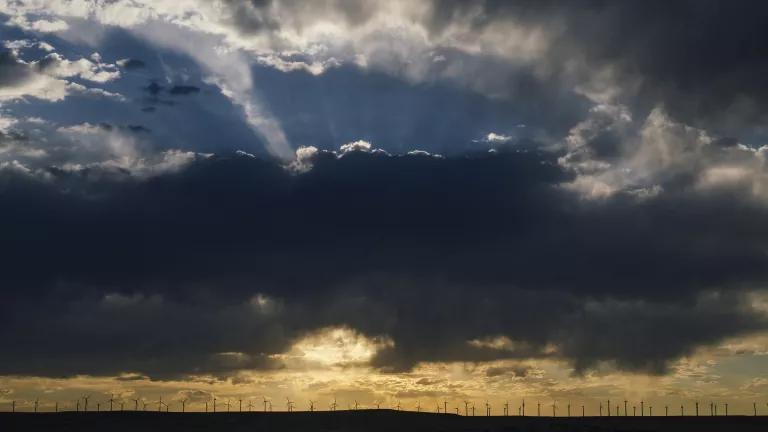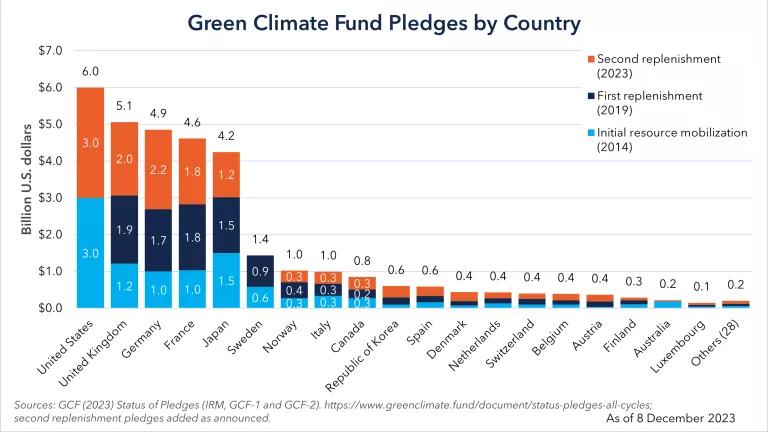The IPCC Report Isn’t a Death Knell. It’s a Wake-Up Call.
We have the ideas—and the means—for reducing emissions and lowering temperatures at our disposal. We just need to act on them.

A wind energy project in Wyoming
Nick Cote for NRDC
We have the ideas—and the means—for reducing emissions and lowering temperatures at our disposal. We just need to act on them.
The latest report from the Intergovernmental Panel on Climate Change (IPCC), released two weeks ago, has sent shock waves around the globe. In it, the world’s leading climate scientists—more than 90 of them, hailing from 40 countries—stipulate that humanity can no longer afford to debate the basic scientific fact of global warming or argue over which country or generation deserves the lion’s share of blame or costs. What we must be doing, they say, is taking “rapid, far-reaching and unprecedented” action to reduce our greenhouse gas emissions by adopting clean energy solutions and maximizing energy efficiency on a worldwide scale. Or, as NRDC’s president Rhea Suh recently put it, “We can do this . . . but we have about a decade—tops—to get it right.”
The IPCC report focuses on what will likely happen to the earth’s natural systems if we’re unable to limit global warming to 1.5 degrees Celsius above the preindustrial norm. But the biggest and most important takeaway from the report isn’t actually about temperature. It’s about time. Every minute that we spend arguing, blaming, withdrawing, or despairing is a minute wasted. And we don’t have a single one of those minutes to spare.
Instead, we need to be making immediate and dramatic—but entirely doable—changes to our means of energy production and distribution, as well as to those sectors that are responsible for the bulk of America’s greenhouse gas emissions: power plants and transportation. And believe it or not, there really is some good news on this front. The blueprint for such change already exists.
Last fall, my organization teamed up with the internationally known consulting group Energy + Environmental Economics (E3) to release a report designed as a guide for policymakers at all levels who are looking to take the kind of action required to slash emissions. Our report, America’s Clean Energy Frontier: The Pathway to a Safer Climate Future, made it clear that we actually have at our disposal the tools to set the United States down the path to a carbon-free energy system. Though our models were geared toward a slightly different target—reducing U.S. emissions by 80 percent by 2050, in order to limit warming to 2.0 degrees Celsius by the end of the century—the clean energy and efficiency solutions are the same ones we’ll need to adopt if we’re to heed the IPCC’s call and level up our commitment.
The truth is, these revolutionary ideas and dramatic changes aren’t theoretical. They’re already happening. They just need to be happening much faster and at a much larger scale.
NRDC’s approach illustrates how three key strategies could actually take us 90 percent of the way to the 80 percent goal. Meeting the more stringent target to limit warming to 1.5 degrees Celsius will require going even faster on these key strategies (as well as the others described in our report):
- We cut energy use by nearly half through ramped-up investment in efficient and/or electric vehicles, appliances, buildings, and industrial plants. The basic idea: If we use less energy to begin with, we’ll automatically shrink the demand for fossil fuels to heat our homes or power our gadgets. Less use of fossil fuels means less harmful and climate-changing pollution. Waste less, use less, pollute less!
- We greatly expand our production of renewable energy so that wind and solar power represent at least 70 percent of our electricity mix by 2050—and renewable energy, as a whole, accounts for at least 80 percent.
- We use this near-zero-carbon electricity to displace direct use of fossil fuels. Think electric vehicles that charge overnight using wind power, or electric heat pumps instead of natural-gas heating in our homes.
Imagine if every new home, office building, and factory were built according to codes that resulted in a significant savings of both energy and money; if existing buildings were retrofit and improved, increasing both their efficiency and their market value; and if the United States were to universally adopt energy-saving LED lighting for its buildings sector. Our study concludes that by implementing new energy efficiency technologies and approaching the whole idea of energy efficiency systematically—as opposed to piecemeal—we could slash energy demand in the United States by a staggering 40 percent. Now add to that scenario the image of our gas-powered cars and trucks continuing to boost their fuel economy such that they average 80 miles per gallon by 2050, even as these vehicles make up a smaller percentage of our vehicle fleet thanks to a global shift toward electrification. Finally, picture America’s cities implementing policies that boost density and encourage mass transit, resulting in a 25 percent reduction in annual vehicle miles traveled.
The cost of wind and solar energy continues to fall precipitously—and, not coincidentally, in direct proportion to the amazing technological advancements associated with the production and transmission of these clean energy sources. Over the past decade, for example, the cost of the solar modules that make up our photovoltaic displays has declined by fully 80 percent; in the meantime, in the period from 2009 to 2016, the average long-term power purchase contract for wind energy dropped from $70 per megawatt-hour to less than $20. And there’s every sign that prices will continue to drop as infrastructure scales up, in a beneficent cycle. Our report anticipates that renewables such as these will represent the lowest-cost form of new power all across the United States by 2023. Accelerating the inevitable transition to a renewables-based energy economy through increased investment in and expansion of wind and solar can help get us to the point where these two sources alone account for more than 70 percent of our electricity supply by 2050.
At that point, we can capitalize on the resulting near-zero-carbon electricity by displacing, as much as possible, the oil and natural gas that’s directly burned in our vehicles, space heaters, water heaters, and factories. One of the best examples of what we call “beneficial electrification” are electric vehicles. With battery prices falling rapidly, global sales of electric cars are predicted to increase rapidly over the next decade. Our study assumes that the vast majority of new cars sold in the United States by 2050 will be electric. While efficient natural gas–burning heaters were touted as the cleaner and cheaper option just a few years ago, rapid technology advances in electric heat pumps have made low-carbon electricity for heating and cooling the more economic, low-emissions option.
The IPCC report doesn’t have to be thought of as a death knell. It’s perfectly appropriate to think of it as a wake-up call. Even if our federal government has fallen down on the job, the United States—as the world’s second-largest emitter of greenhouse gases—has an outsize obligation to take action on reducing those emissions. We can, and we will. What we can’t do is wait.


